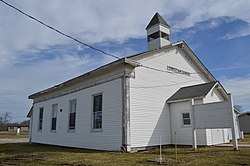History
On October 17, 1820, the government granted 160 acres to John and Simeon Barber/Barbour. Andersonville, the original town known as Ceylon, was laid out in October 1831 by Simeon Barber in 1831. It was 78 lots. The original streets (in use today) were laid out 66 feet wide and alleys were 16+1⁄2 feet wide. The Anderson Addition was laid out by Joel (Joseph) Anderson and Fletcher Tevis in 1837 with additional lots and streets. Anderson P.O. was established. The two additions merged and it was renamed in 1849 after Thomas Anderson, a tavern owner. In 1915, Andersonville had about 350 inhabitants. [2]
This page is based on this
Wikipedia article Text is available under the
CC BY-SA 4.0 license; additional terms may apply.
Images, videos and audio are available under their respective licenses.


